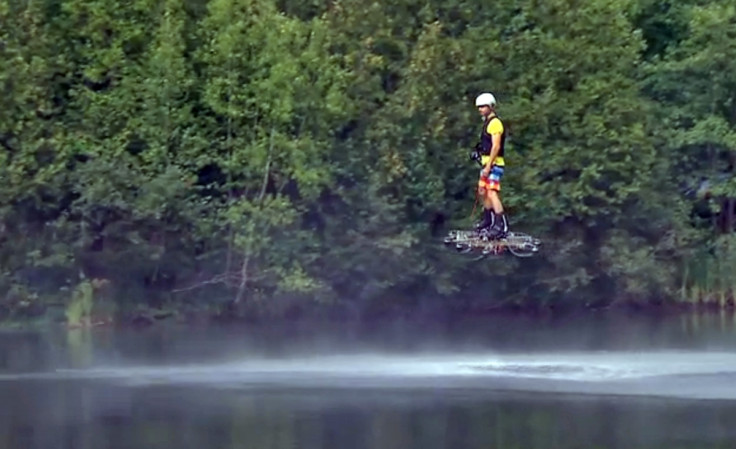Flyboard Air hoverboard: Zapata Industries has been sold to US explosives detection firm
Franky Zapata's hydro and jet powered technology company has been bought by Implant Sciences.
Hoverboards could be coming to the military and industrial fields sooner than you think, as French jet-ski champion Franky Zapata's hydro and jet powered sporting technology firm Zapata Industries has been sold to Implant Sciences in the US.
Zapata, 37, is well known for his Flyboard Pro jet platform and previously held the world record for the most backflips with a water jet pack in one minute, before deciding to develop a jet-powered hoverboard called the Flyboard Air.
He used his invention to set a new Guinness World Record in May for the furthest ever hoverboard fligh by flying 100ft above choppy coastal waters, skirting the coastline for six or seven minutes before eventually reaching a top speed of about 44mph.
The Flyboard Air is powered by jet engine propulsion and features a joystick wired to the base in order to control the direction, height and speed of the hoverboard. The device is touted as being able to reach heights of up to 10,000ft and hit a top speed of 95mph.
Not much information has been released on the device, but Flyboard Air has received waves of international attention since it first debuted in April – with inventors racing to be the first to realise the consumer hoverboards, featured in the much-loved 1980s flick Back to the Future II.
The firm that bought Zapata Industries is Implant Sciences, a Massachusetts-based company that specialises in manufacturing devices which can detect traces of explosives and drugs for the US Department of Homeland Security, according to Gizmag.
Itis believed that Implant Sciences is keen to diversify its offerings and get the Flyboard Air to be used by the US military, as well as in industrial and medical fields, perhaps as a tool to help travel around tricky industrial sites like offshore oil rigs or wind turnbines, or to deliver organs or medical aid in an emergency.

Flyboard Air's competitiors
Before Zapata entered the hoverboard race, the previous Guinness world record was set by Canadian Catalin Alexandru Duru, 31 – the inventor of the Omni Hoverboard – in May 2015, when his invention was able to fly a distance of 905ft at a height of 16ft in the air in just 90 seconds.
Duru's invention features eight propellers and a frame made from carbon fibre, with motors powered by 12 lithium polymer batteries, and it too is controlled by a joystick. However, it can only fly for 90 seconds.

Besides Duru and Zapata's inventions, in the hoverboard category there is also the crowdfunded Hendo Hoverboard and the Lexus Hoverboard, but they work in a different way and neither of those designs go very far off the ground.
The Hendo works by magnetics and can only be used in a special purpose-built conductive rink, while the Lexus uses superconductors and magnets that work against gravity to lift the board, as liquid nitrogen cools the superconductors, giving off steam on both sides of the board.
Since Duru's hoverboard is still at the prototype stage, Zapata's Flyboard Air, which looks like a polished product, could make it to market first and beat out the hoverboards currently competing today.
© Copyright IBTimes 2025. All rights reserved.






















